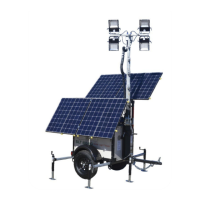23TriStar MPPT Operator’s Manual
22
Installation
Switches 4, 5, & 6: Battery Charging Settings
It is important to select the battery type that matches the system battery to ensure proper charging
and long battery life. Refer to the specications provided by the battery manufacturer and choose a
setting that best ts the recommended charging prole.
Settings
Switches
4 - 5 - 6
Battery
Type
Absorp.
Stage
(Volts)
Float
Stage
(Volts)
Equalize
Stage
(Volts)
Equalize
Interval
(Days)
o-o-o 1 - Gel 14.00 13.70
o-o-on 2 - Sealed
1
14.15 13.70 14.40 28
o-on-o 3 - Sealed
1
14.30 13.70 14.60 28
o-on-on 4 - AGM/Flooded 14.40 13.70 15.10 28
on-o-o 5 - Flooded 14.60 13.50 15.30 28
on-o-on 6 - Flooded 14.70 13.50 15.40 28
on-on-o 7 - L-16 15.40 13.40 16.00 14
on-on-on 8 - Custom Custom Custom Custom Custom
1
“Sealed” battery type includes gel and AGM batteries
All settings are for 12 Volt nominal systems. Multiply the charge voltage settings by 2 for 24 Volt sys-
tems or by 4 for 48 Volt systems. A description of each setting is provided below. See section 4.3 for
full details on battery charging and a description of each of the settings in the battery charging table.
Battery Type - The most common battery type associated with the specied charging settings.
Absorption Stage - This stage limits input current so that the Absorption voltage is maintained. As the
battery becomes more charged, the charging current continues to taper down until the battery is fully
charged.
Float Stage - When the battery is fully charged, the charging voltage will be reduced to the Float volt-
age setting.
Equalize Stage - During an equalization cycle, the charging voltage will be held constant at the speci-
ed voltage setting.
Equalize Interval - The number of days between equalization charges when the controller is cong-
ured for automatic equalizations (settings switch 7).
Switch 7: Battery Equalization
Choose between manual and automatic battery equalization charging. In the manual equalization
setting, an equalization will only occur when manually started with the push-button or when requested
from the equalize menu on the TriStar meter. Automatic equalization will occur according to the bat-
tery program specied by settings switches 4, 5, & 6 in the previous step.
In both settings (auto and manual), the push-button can be used to start and stop battery equaliza-
tion. If the selected battery charging setting does not have an equalization stage an equalization will
never occur, even if requested manually.
Equalize Switch 7
manual OFF
automatic ON
Switch 8: Ethernet Security
The Ethernet Security switch enables or disables conguration of the TriStar MPPT 150V set-
tings through the Ethernet connection. When switch eight is set to disabled, write commands to the
TriStar MPPT 150V custom memory are not allowed. This a safety feature to prevent unintended
changes to custom settings, but it is not a replacement for proper network security.
Conguration via TCP/IP Switch 8
disabled OFF
enabled ON
NOTE:
Adjustment of network settings and custom set-points is always enabled via the
RS-232 and EIA-485 connections. The Ethernet Security switch only enables/
disables remote conguration via TCP/IP.
CAUTION: Risk of Tampering
The Ethernet Security settings switch does not block write commands to devices
bridged via EIA-485.
REMARQUE :
Le réglage des paramètres de réseau et des points de consignes personnalisés
est toujours activé par les connexions RS-232 et EIA-485. Le contacteur de
sécurité Ethernet n’active/désactive que la conguration à distance par TCP/IP.
PRUDENCE : Risque de tentative d’altération
Le contacteur des paramètres de sécurité Ethernet ne bloque pas les
commandes d’écriture sur les dispositifs reliés par EIA-485.

